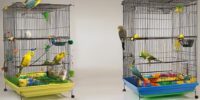When to Seek Expert Advice on Parrot Species Compatibility
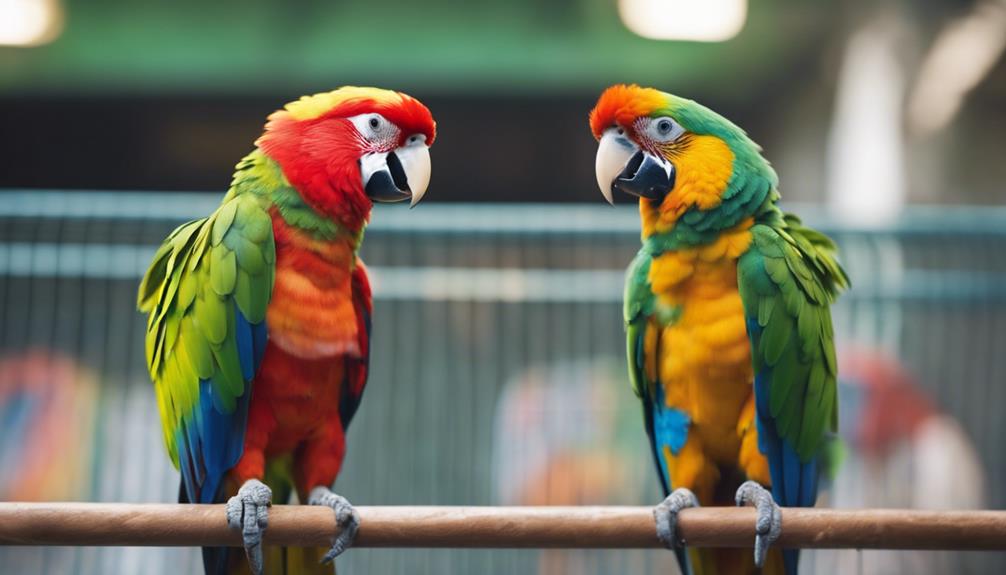
When considering adding a new parrot to your household, it is crucial to ensure compatibility with any existing birds. Seeking expert advice on parrot species compatibility can help prevent potential conflicts and ensure a harmonious environment for all feathered friends. Key signs that may indicate a need for expert advice include aggressive behavior, excessive fighting, or persistent stress among the birds. Factors to consider when assessing compatibility include the size, temperament, and social needs of each parrot species. Consulting with a knowledgeable avian veterinarian or a reputable bird behaviorist can provide valuable insights and guidance on introducing a new parrot successfully. Remember, the well-being of your birds should always be the top priority.
Seeking expert advice on parrot species compatibility is essential for creating a peaceful and thriving multi-bird household. It is important to be proactive in addressing any signs of tension or aggression among your feathered companions. By understanding the key factors that influence compatibility and consulting with knowledgeable professionals, you can ensure a happy and healthy environment for all your parrots. Don't hesitate to reach out for expert advice whenever needed to promote positive interactions and strong bonds among your bird flock.
Understanding Parrot Social Dynamics
Understanding the parrot social dynamics is crucial for creating harmonious environments in multi-species aviaries. Parrots, like many other social animals, establish dominance hierarchies within their groups. These hierarchies determine the relationships between individuals and play a significant role in the overall dynamics of the flock. By understanding these dominance hierarchies, caretakers can better anticipate potential conflicts and take proactive measures to prevent them.
Socialization techniques are essential tools in managing parrot social dynamics. Proper socialization from a young age can help parrots develop important social skills and adapt to living with other species. Encouraging positive interactions through supervised playtimes and structured activities can foster a sense of community within the aviary. Additionally, providing opportunities for social learning and group bonding can strengthen the relationships between different parrot species.
Recognizing Signs of Compatibility Issues
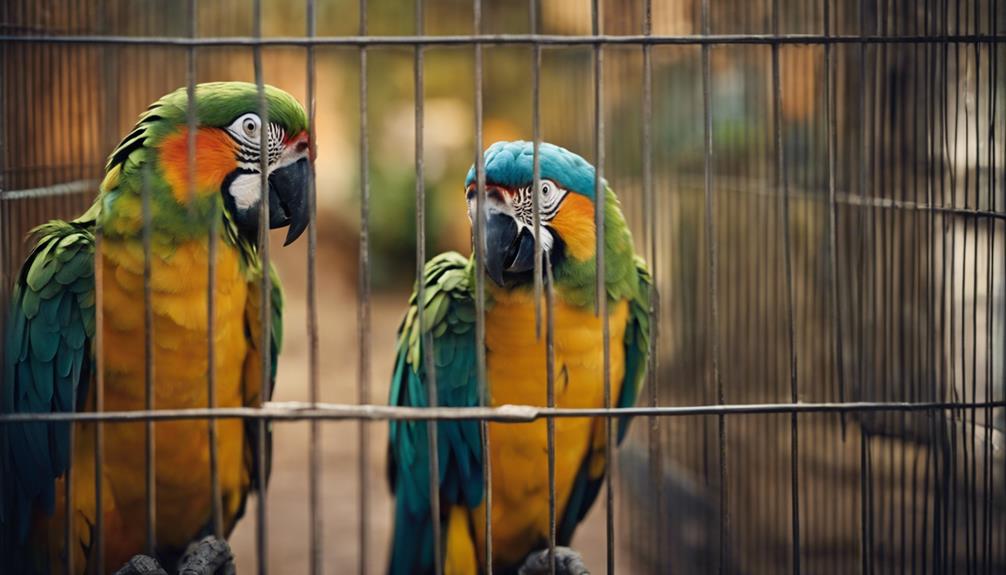
Observing behavioral red flags, such as excessive screaming or feather plucking, can indicate potential compatibility issues between parrot species.
Aggressive interactions, like biting or territorial behavior, may also signal underlying tensions that could lead to conflict.
Communication breakdowns, where parrots struggle to understand each other's cues or body language, are crucial signs that shouldn't be overlooked when assessing compatibility.
Behavioral Red Flags
Signs of potential compatibility issues between parrot species can manifest through behavioral red flags, indicating the need for careful observation and expert guidance.
Understanding triggers such as body language cues and vocalizations is crucial when introducing parrots to each other. Body language cues like feathers raised, aggressive beak posturing, or pinned eyes can signal potential conflict. Similarly, vocalizations such as loud screams, hissing, or growling may indicate discomfort or aggression.
Employing proper socialization techniques, like gradual introductions in a neutral space, can help mitigate these issues.
Aggressive Interactions
Recognizing aggressive interactions between parrot species is crucial in identifying potential compatibility issues that may arise during their interactions. Proper aggression management, stress prevention, behavioral modification, and conflict resolution techniques are essential in ensuring the well-being of the birds. By understanding the signs of aggression and stress, owners can intervene early to prevent any serious conflicts between their parrots. Below is a table summarizing key behaviors to watch for:
| Aggressive Interactions | Signs to Look For |
|---|---|
| Aggressive body language | Wing flaring, beak fencing |
| Vocalizations | Loud screeching, hissing |
| Physical attacks | Biting, chasing |
| Food or resource guarding | Aggressive behavior around food bowls or toys |
These behaviors should prompt immediate action to address the underlying issues and seek expert advice if needed.
Communication Breakdowns
To ensure harmonious interactions between parrot species, understanding the nuances of communication breakdowns is imperative in preempting compatibility issues that may arise. Warning signs of communication breakdowns in parrot interactions include increased vocalization, aggressive body language, feather fluffing, and avoidance behaviors. These signs may indicate underlying conflicts that need to be addressed promptly to prevent escalation.
Conflict resolution strategies such as providing separate spaces for the parrots, introducing positive reinforcement training, and seeking guidance from a certified avian behaviorist can help mitigate these issues. By recognizing these warning signs early and implementing effective conflict resolution techniques, parrot owners can foster a peaceful coexistence between their feathered companions and prevent potential compatibility issues.
Factors Influencing Species Compatibility
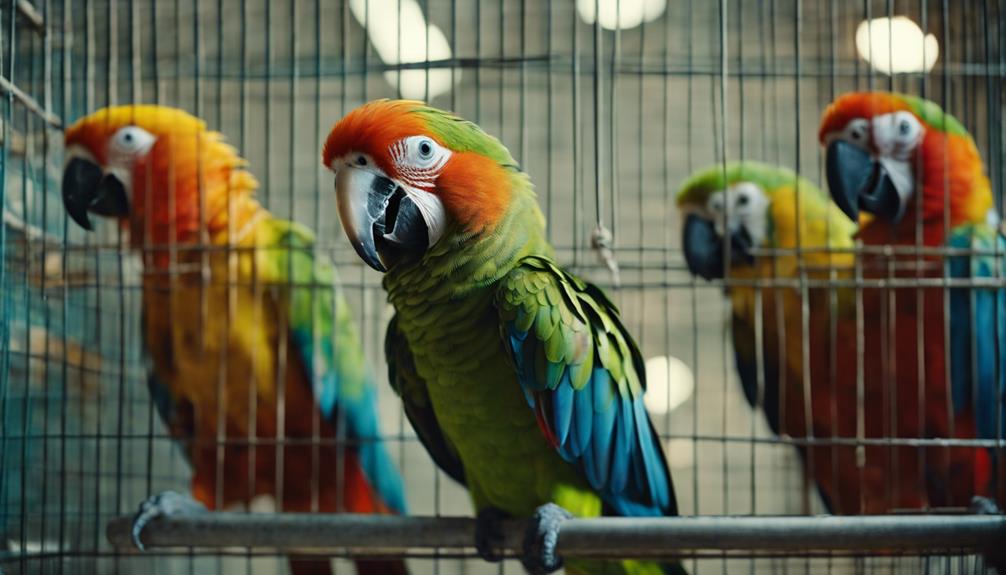
Species behavior traits and environmental needs compatibility are crucial factors influencing the compatibility of different parrot species. Understanding how each species interacts, communicates, and establishes dominance within a shared environment is key to predicting potential conflicts.
Additionally, ensuring that the environmental requirements, such as space, temperature, and diet, align for all species involved can significantly impact their ability to coexist harmoniously.
Species Behavior Traits
Understanding the behavior traits of different parrot species is essential for determining their compatibility when kept together in the same environment. When considering parrot species behavior, factors such as pair bonding and social hierarchy play a crucial role in predicting how they'll interact with each other. Here are four key behavior traits to consider:
- Communication Styles: Different parrot species have varied ways of communicating, which can impact how they interact with other species.
- Aggression Levels: Some species are more territorial or aggressive, which may lead to conflicts when housed with other species.
- Activity Levels: Varying activity levels can cause stress or frustration if not compatible among species.
- Dietary Needs: Species with different dietary requirements may struggle to coexist peacefully when sharing the same space.
Environmental Needs Compatibility
Considering the diverse environmental needs of different parrot species is crucial in determining their compatibility when cohabitating. Habitat requirements play a significant role in ensuring the well-being of parrots. Some species, like the African Grey Parrot, require large cages with plenty of mental stimulation, while others, such as lovebirds, thrive in smaller, cozy environments.
Behavioral adaptations, such as noise levels and activity patterns, also influence compatibility. Social interactions are essential for species like conures, which are highly social and require companionship, whereas others, like the Eclectus parrot, are more independent.
Additionally, understanding the nutritional needs of each species is vital to prevent conflicts over food resources. By considering these factors, one can create a harmonious living environment for parrots with differing environmental requirements.
Importance of Avian Behavior Specialists
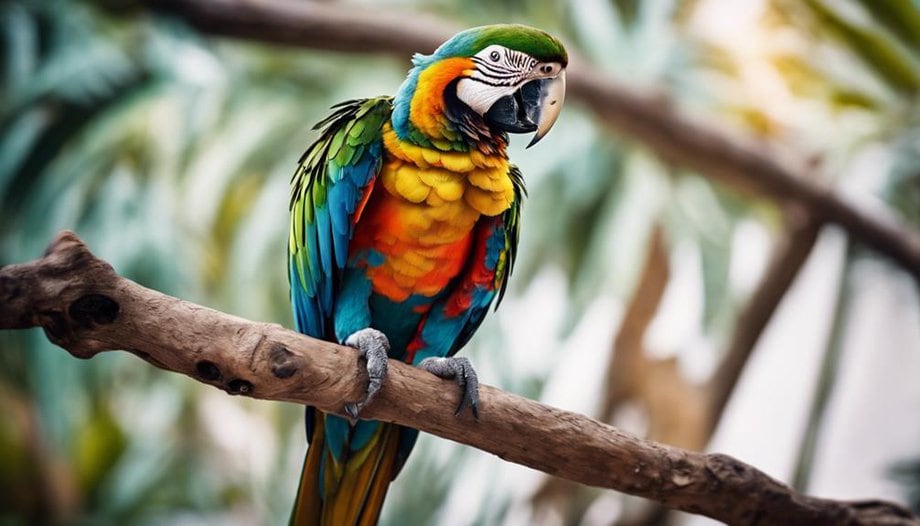
Expert advice from avian behavior specialists is crucial when assessing the compatibility of different parrot species. These professionals offer valuable insights into the behavioral intricacies of various parrot species, helping to ensure harmonious interactions in multi-bird households.
Importance of Avian Behavior Specialists:
- Behavioral Consultations: Avian behavior specialists conduct in-depth consultations to understand the unique behavioral traits and needs of each parrot species involved.
- Expert Guidance: They provide expert guidance on how to identify signs of stress, aggression, or discomfort in parrots, crucial for maintaining a peaceful environment.
- Compatibility Assessments: These specialists conduct thorough assessments to determine the compatibility between different parrot species, considering factors like temperament, social structure, and communication styles.
- Species Interactions: Avian behavior specialists offer recommendations on how to facilitate positive interactions between parrot species, fostering a safe and enriching environment for all birds involved.
Seeking Consultation Before Introducing New Parrots
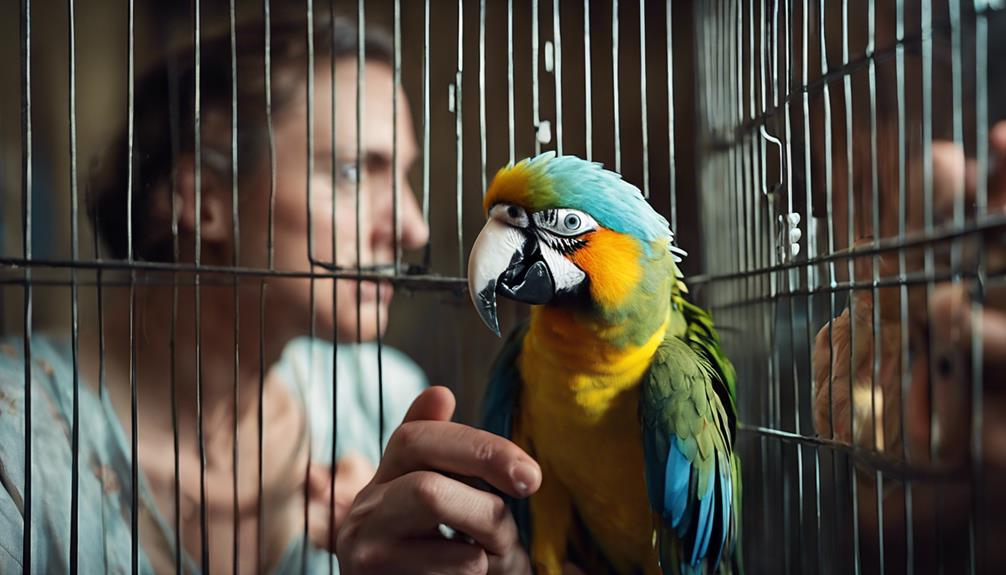
Avian behavior specialists play a pivotal role in guiding pet owners on the importance of seeking consultation before introducing new parrots into a household. When considering parrot introductions, consultation with experts is crucial to ensure species compatibility and prevent potential issues such as aggression and stress. Expert advice in this context goes beyond basic information on parrot care; it delves into the intricacies of avian behavior, social dynamics, and individual personalities to make informed decisions that promote the well-being of both new and existing feathered companions.
Seeking consultation before introducing new parrots allows pet owners to gain insights into the specific needs and behaviors of different parrot species. This knowledge can help in creating a harmonious environment where all birds can thrive. Expert guidance can also aid in recognizing early signs of potential conflicts or stress, enabling proactive measures to be taken to address these issues effectively. By prioritizing consultation before introducing new parrots, pet owners demonstrate a commitment to responsible pet ownership and the welfare of their avian companions.
Addressing Aggression and Stress in Parrots
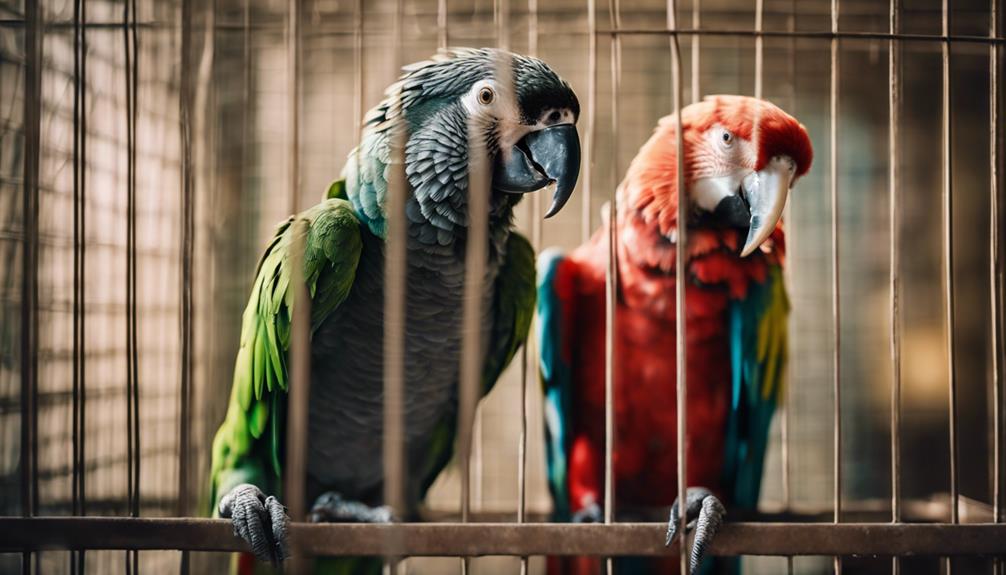
When addressing aggression and stress in parrots, understanding their individual behaviors and triggers is essential for effective management and intervention. Parrots, like humans, can exhibit signs of stress and aggression for various reasons. Here are some key points to consider when dealing with these issues:
- Behavioral Observation: Spend time observing your parrot to identify specific behaviors indicating stress or aggression.
- Environmental Enrichment: Provide a stimulating environment with toys, perches, and opportunities for mental and physical exercise to reduce stress and prevent aggression.
- Consistent Routine: Establish a consistent daily routine for feeding, playtime, and sleep to help minimize stress levels in your parrot.
- Positive Reinforcement Training: Utilize positive reinforcement techniques to encourage desirable behaviors and discourage aggressive tendencies in your parrot.
Ensuring a Peaceful Multi-Species Environment
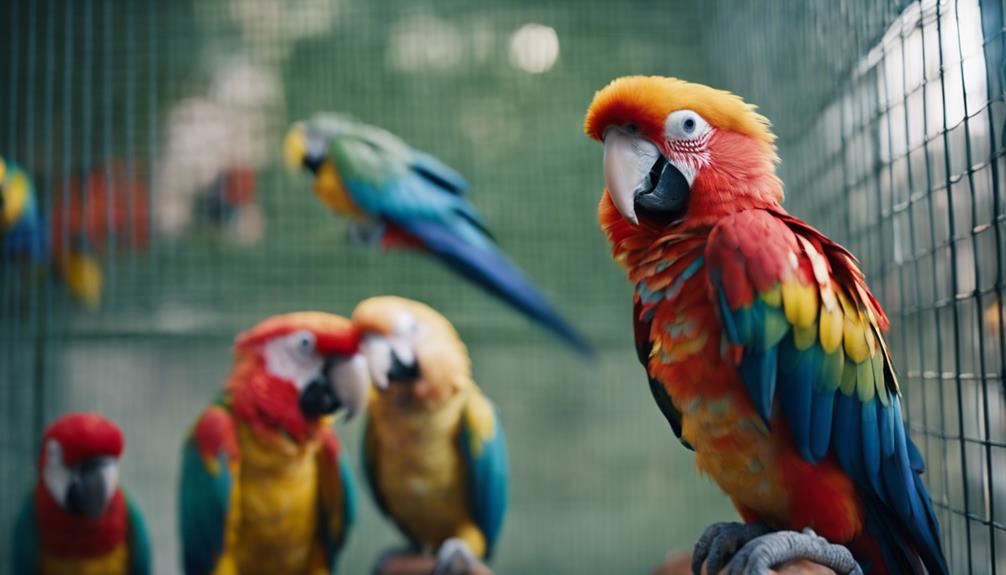
Understanding the dynamics of cohabitating multiple species of parrots requires careful consideration of their individual temperaments and social hierarchies. Species interactions play a crucial role in ensuring a peaceful multi-species environment. When introducing different parrot species to each other, conducting a thorough behavior assessment is essential. This assessment involves observing how each species reacts to the presence of others, their communication styles, and any signs of aggression or stress. By understanding the unique behaviors and communication cues of each species, caregivers can proactively address potential conflicts and create a harmonious living space for all parrots involved.
Behavior assessment also helps in identifying any dominant or submissive individuals within the group. Establishing a clear hierarchy can minimize power struggles and reduce the chances of aggressive behavior. Providing ample space, enrichment activities, and separate feeding areas can further promote positive interactions among different parrot species. By prioritizing species compatibility and promoting a peaceful cohabitation environment, caregivers can ensure the well-being and happiness of all their feathered companions.
Frequently Asked Questions
Can Parrots of Different Species Ever Become Best Friends, or Will They Always Have Some Level of Competition or Aggression Towards Each Other?
Parrots of different species can form strong bonds and companionships, influenced by their social dynamics and behavior. While some may have natural competition or aggression, expert advice can help navigate and foster positive relationships among them.
How Do Parrots Communicate With Each Other, and How Can Understanding Their Communication Help in Assessing Compatibility Between Different Species?
Parrots communicate through body language and vocalizations to establish social dynamics and hierarchy. Understanding these cues can help assess compatibility between different species. Expert advice should be sought when unsure about interpreting these signals accurately.
Are There Any Specific Environmental Factors, Such as Cage Size or Placement, That Can Impact the Compatibility Between Different Parrot Species Living Together?
To ensure harmonious living between different parrot species, considering cage requirements, socialization methods, behavioral cues, and environmental enrichment is crucial. These factors play a significant role in fostering compatibility and reducing potential conflicts.
What Are Some Common Mistakes That Owners Make When Trying to Introduce New Parrots to Each Other, and How Can These Be Avoided to Ensure a Smooth Transition?
When introducing new parrots, common mistakes include lack of behavioral training, improper socialization, and inadequate supervision. To avoid issues, owners should focus on proper introductions, encourage positive interactions, and closely monitor their birds.
How Do Parrots Express Stress or Aggression Towards Each Other, and What Steps Can Be Taken to Address These Issues Before They Escalate?
Parrots express stress or aggression through vocalizations, body language, and feather ruffling. Training techniques like positive reinforcement and environmental enrichment can address these issues. Bonding process and socialization methods play vital roles in fostering harmonious interactions among parrots.




